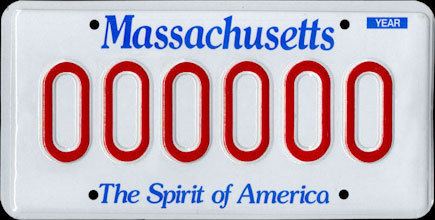 | ||
Massachusetts was the first U.S. state to issue license plates, on September 1, 1903.
Contents
Passenger plates 1903 to 1966
In 1956, the U.S. states and Canadian provinces came to an agreement with the Automobile Manufacturers Association that fixed the size for license plates for vehicles, except those for motorcycles, at six inches in height by twelve inches in width, with standardized mounting holes. The 1955 (dated 1956) issue was the first Massachusetts license plate that complied with these standards.
Passenger plates 1967 to present
For twenty years, starting in 1967, Massachusetts used three series of license plates that were nearly identical (Blue on White, Red on White, and Green on White). All had the identical semi-rounded letters and numbers and the word MASSACHUSETTS embossed in the same style, with an embossed quarter-inch border a quarter inch from the edge of the plate. The plates changed color twice, in 1972 and 1977; the red plates moved "MASSACHUSETTS" to the bottom of the plate, but the blue 1967 and green 1977 plates had it on the top.
The current "Spirit of America" plates were introduced in 1987. The red number typeface remains virtually the same (though since 2005 the 1s have been serifed and 2010 the "D's" have changed shape to be discernible from a distance), but the border was dropped, and the state name is no longer embossed; it is italicized and blue, and no longer all capital letters. Additionally, the slogan "The Spirit of America" (from an advertising jingle from the early 1980s) was added in the same italicized blue typeface at the bottom. General registration plate, such as Dealer and Repair plates inverse the colors, Mass and Spirit in Red, number in blue.
Since 1969, serials on Massachusetts plates are coded with the month of expiration of the registration as the last numeric character, using 1 for January through 0 for October. X and Y were used from 1969 to 1977 for November and December. Registrants are issued plates expiring the last day of the previous month (i.e., a motorist registering a vehicle in June will be issued May plates). If a vehicle is registered in December or January (so that November and December plates would be called for), leftover plates are issued from other months with manufacturing overruns.
In addition to the standard numbering formats, Massachusetts also issues "reserve" plates. Reserve plates permit the plate holder to receive the same plate number when new plate styles are issued, or to transfer the plate number to family members. These plates are either all-numeric (1 through 99999) or consist of a single letter followed or preceded by a number (A 1 through Z 9999 and 1 A through 9999 Z). Reserve numbers may also be in the form of A#A, A##A, #A#, and #AA#, where # represents any number, and A represents any letter. Low number reserve plates (now called "Lottery Plates" by the RMV), are of the form #, ##, ###, ####, A#, A##, #A, and ##A only. When a registrant cancels a low number reserve registration, the number is placed in an annual lottery ( ). Registration for the lottery generally begins each June, and the drawing must be held by September 15. Prior to the institution of this annual lottery, low digit reserve plates were issued only to well-connected individuals, and it is widely believed that drivers with low registration numbers were given preferential treatment by law enforcement. The annual lottery was instituted in response to complaints about the politics behind the issuance of low-number registrations. As with standard registration plates, the final digit on low number reserve plates also indicates the month of expiration.
Two year registrations are mandatory, with the exception of vehicles initially registered during December or January. Vanity plates and motorcycle plates must be renewed annually. All vanity plate registrations expire on November 30, and all motorcycle and commercial registrations expire on December 31.
Starting with the 1987 "Spirit of Massachusetts" base, the three-letter abbreviation for the month of expiration is either embossed or screened in the upper left corner of the plate, with the exception of vanity plates which do not have the expiration month (NOV) screened or embossed. 'Red' Commercial were initially stamped without the month on the upper left corner, however that has since been added.
Currently, the only common license plate issued in the Commonwealth that is allowed to have more than 6 digits is Livery plates. All livery plate numbers start LV, even if not stamped.
Because the Registry of Motor Vehicles utilizes "Plate Type" to describe the type of registration, it is theoretically possible to have two plates issued with seemingly the same number. The follow describes some, but not all of the types, and the code used on vehicle registration:
Current passenger base plates
Currently, the 1977 green-on-white base as well as the 1987 "Spirit" base is valid for registration. The 1977 base only issued a single (rear) plate (Except Reserved, Commercial, and Taxi. Two plates were issued, thus both must be displayed, even today) whereas for the current "Spirit" base, two plates are issued. Registrants have the option of replacing the 1977 base with the "Spirit" base at no charge (though a different number will be used), however, most choose to keep their 1977 base plate as a point of pride. In many cases, the 1977 base plates are worn and illegible; legally per M.G.L. Ch. 90, a car with an illegible plate (regardless of age or color) must fail the state's annually required vehicle safety inspection. This is a safety fail, which under Mass law prohibits operation of the vehicle until the issue is corrected.
